家庭生活实际污渍布的开发及性能评价
2022-03-19刘蓉熊明周存玲崔阅馨周澳周立亚丁雪梅
刘蓉 熊明 周存玲 崔阅馨 周澳 周立亚 丁雪梅
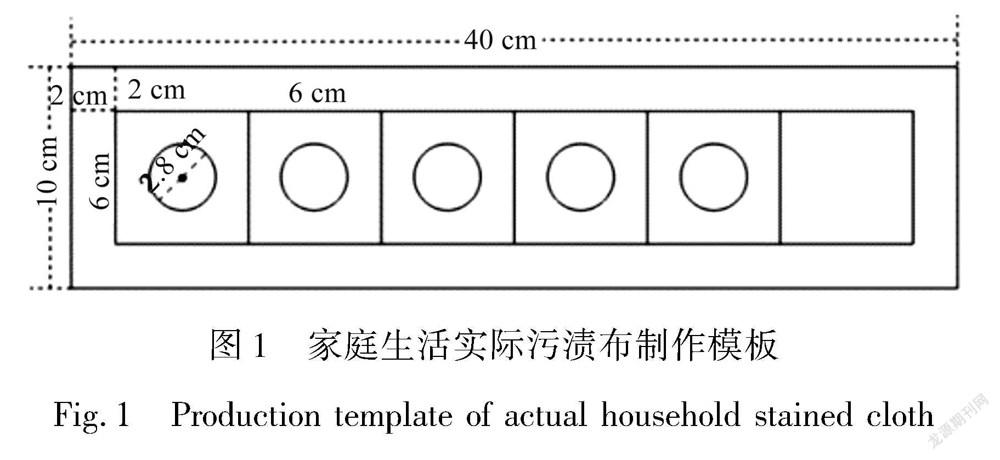
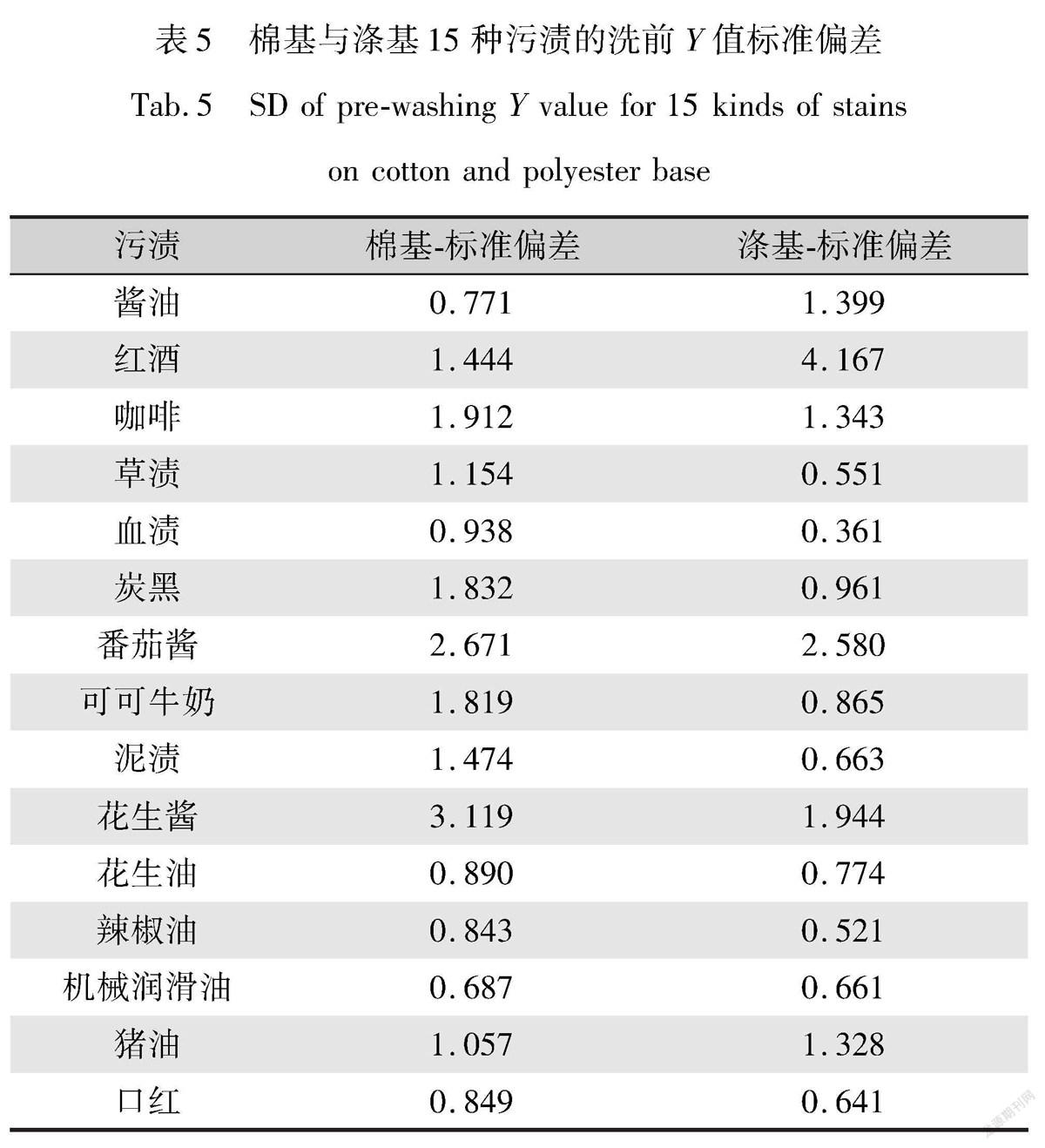
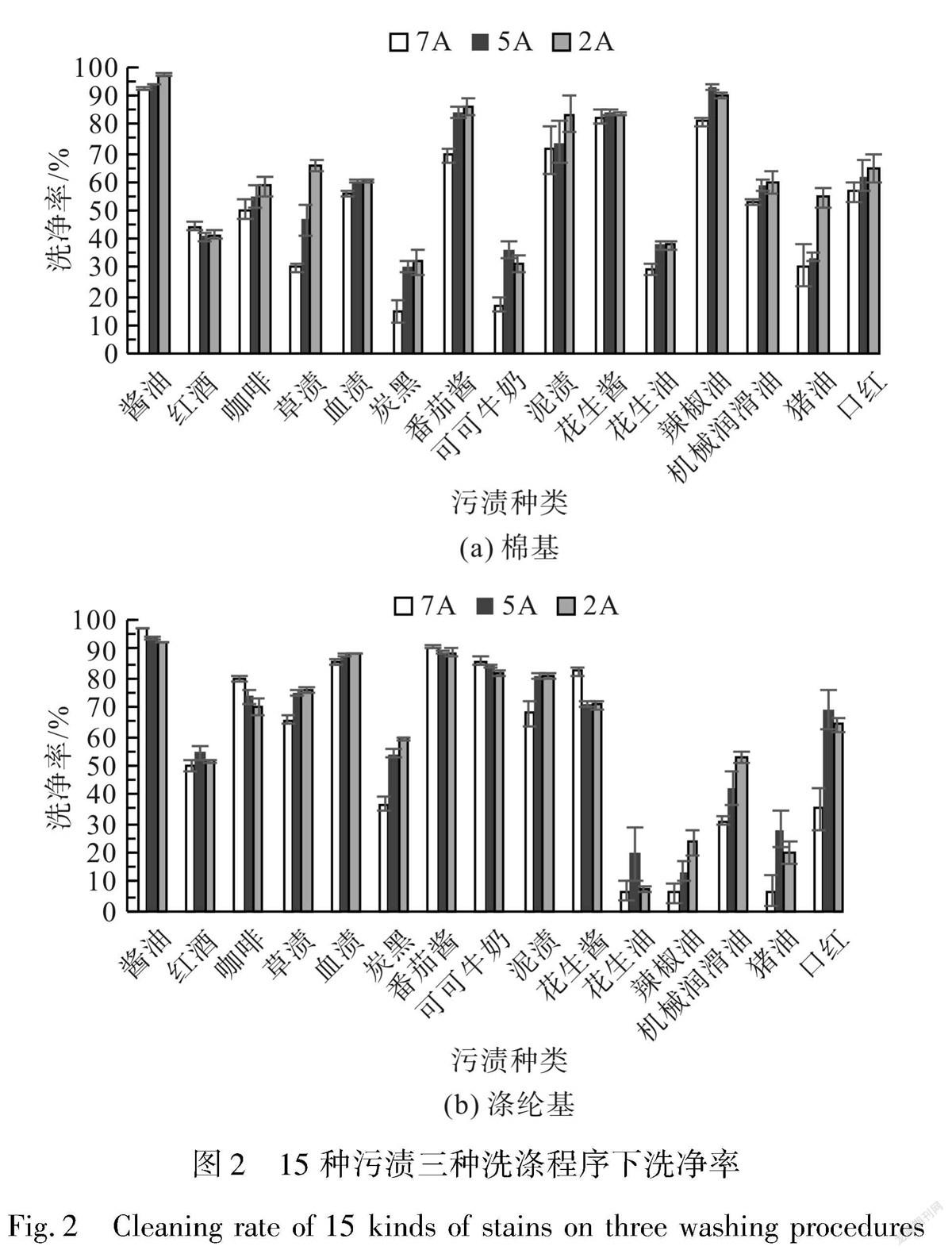

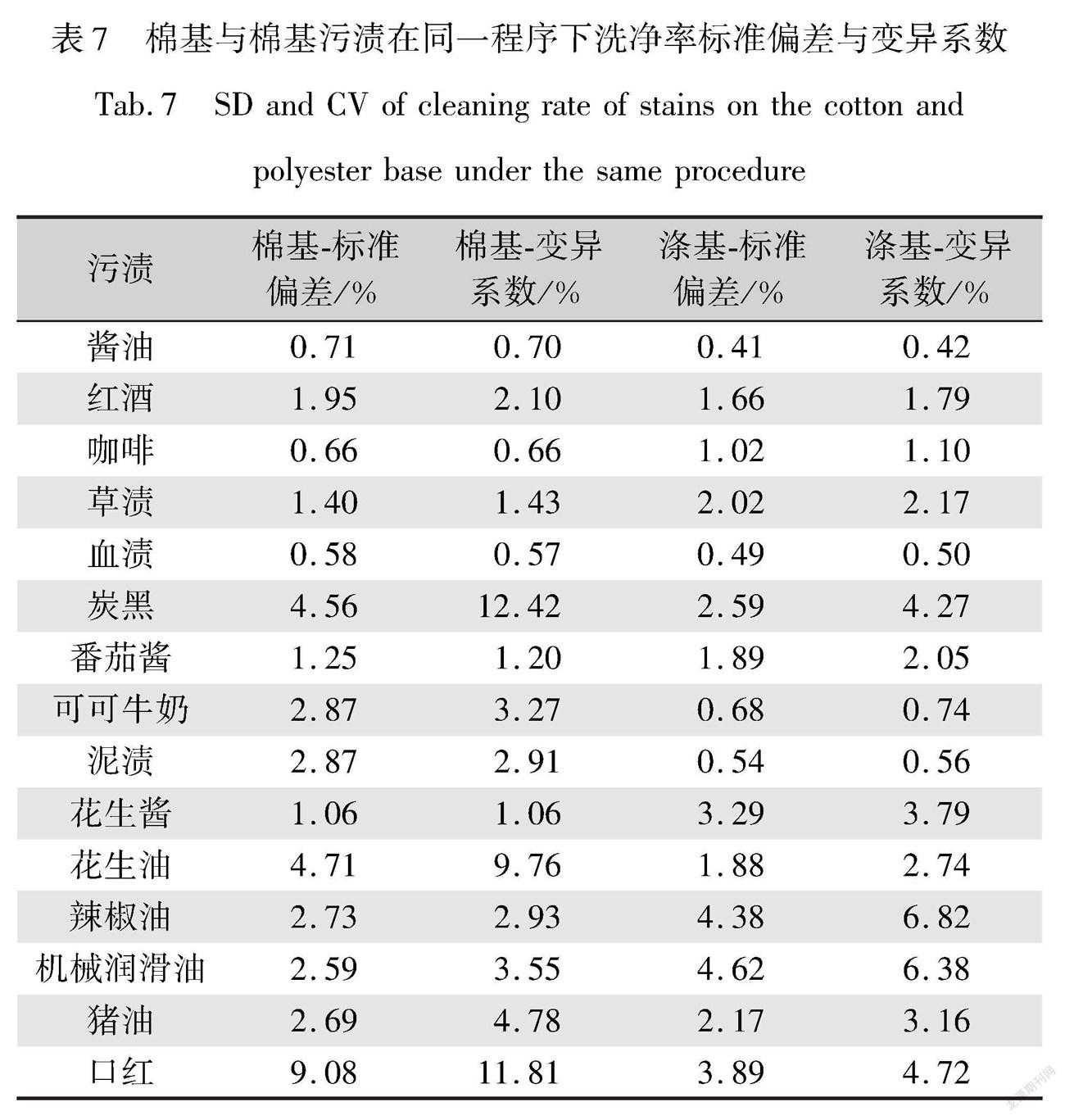
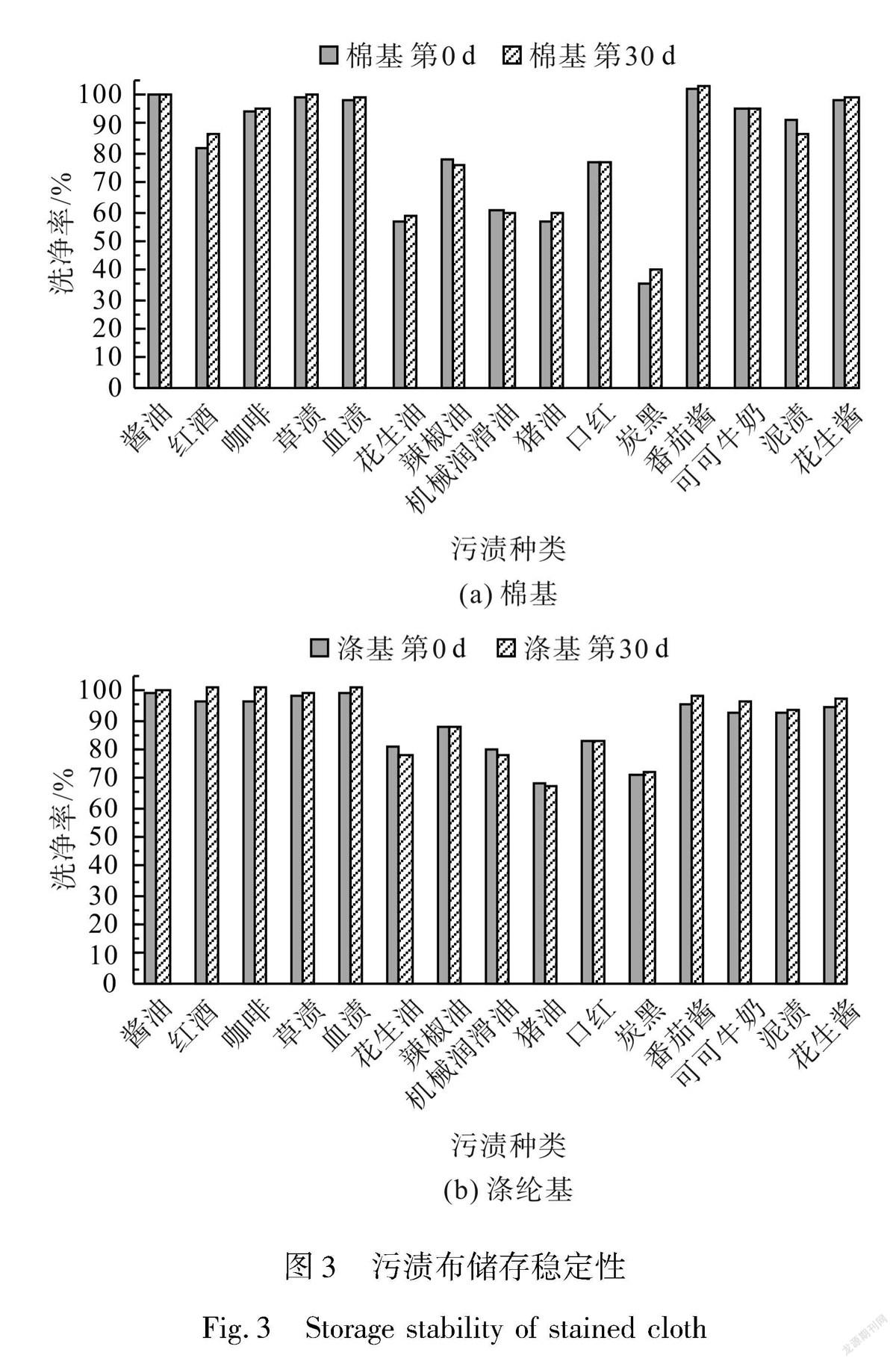
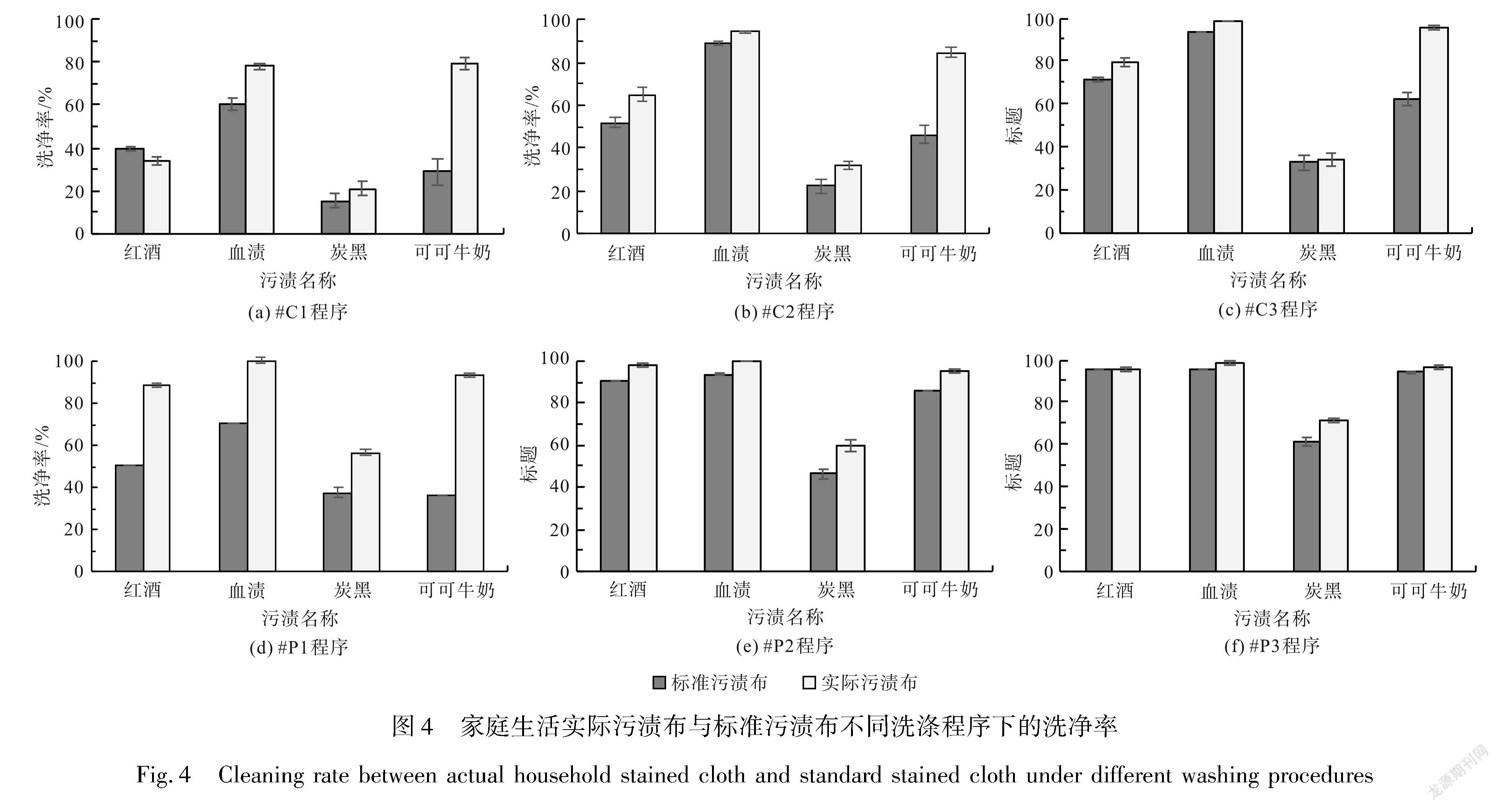
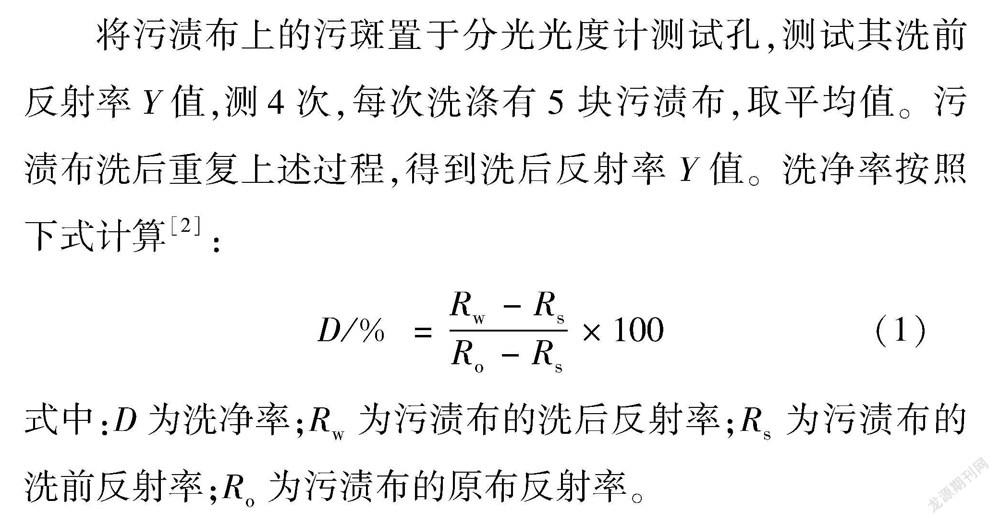

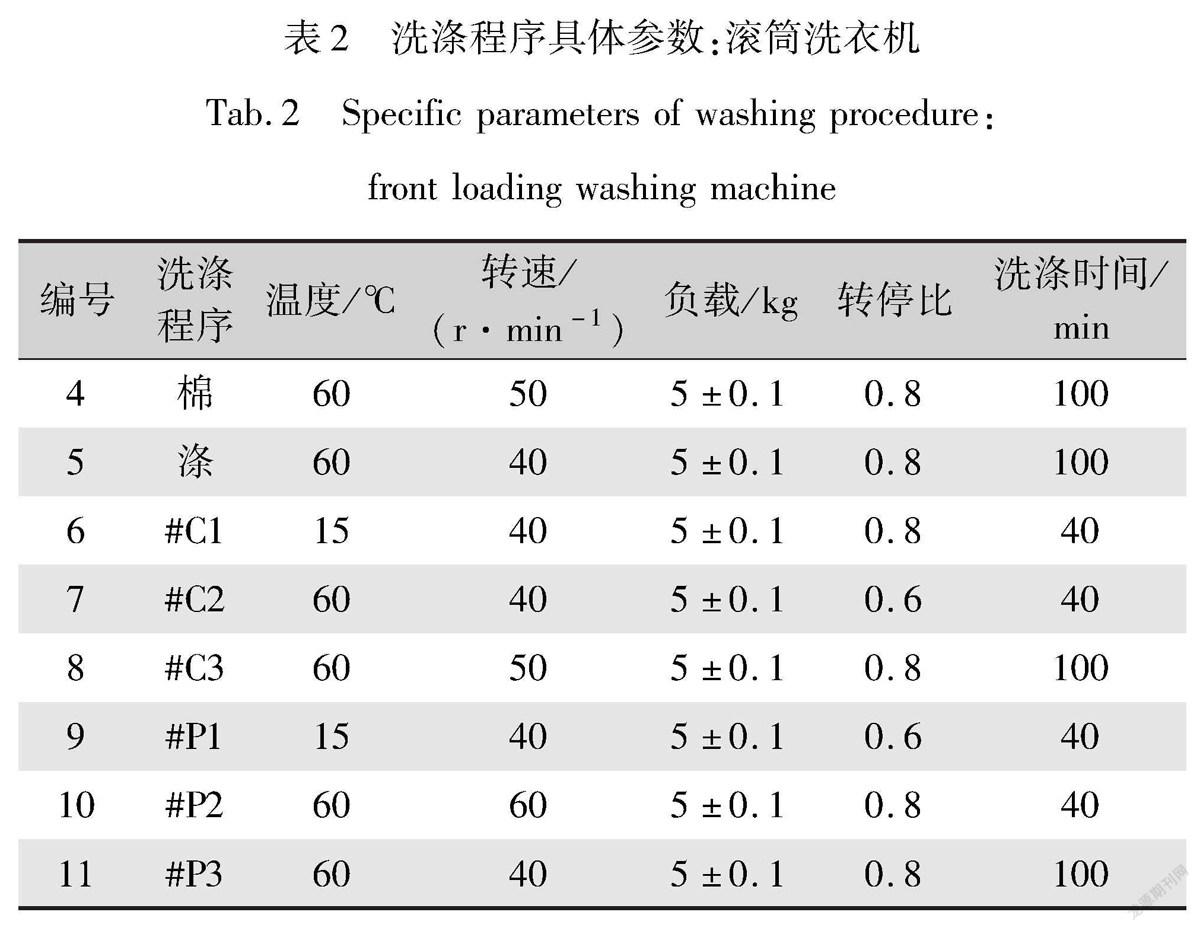
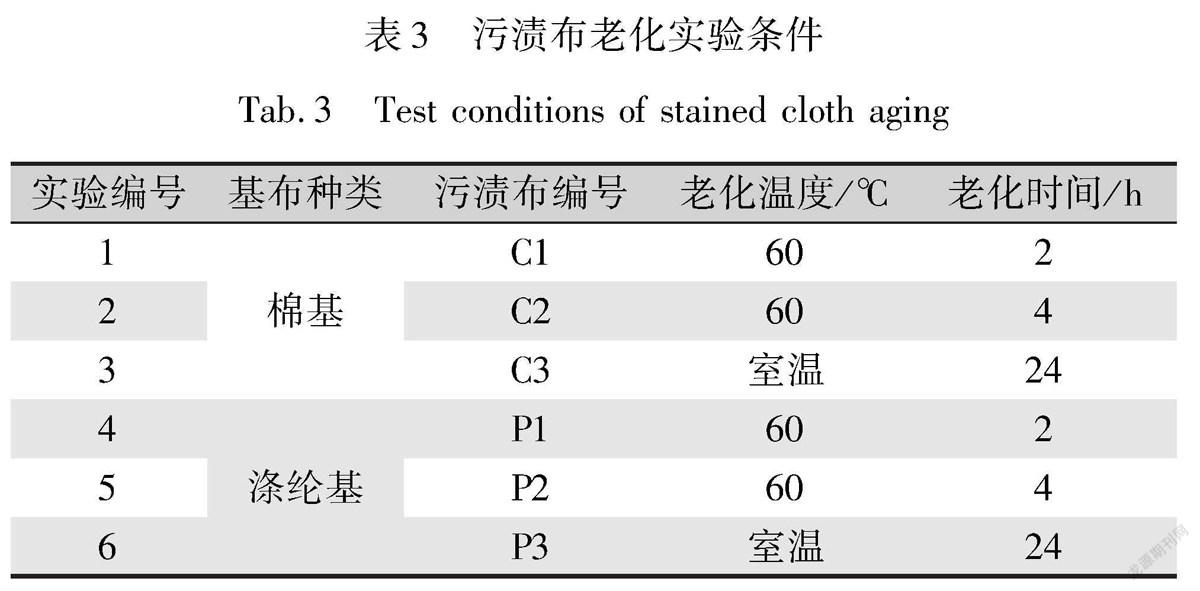

摘要: 选取家庭生活中常见的15种污渍,包括酱油、红酒、咖啡、草渍、血渍、炭黑、番茄酱、可可牛奶、泥渍、花生酱、花生油、辣椒油、机械润滑油、猪油、口红,以针织纯棉布、针织纯涤纶布为基布,通过点染法、刮涂法和填涂法制作污渍布。采用洗衣机洗涤程序的去污效果评价污渍布的质量。结果表明:所制备污渍布的最佳老化条件为温度60 ℃,时间2 h;污渍布洗前反射率差异较小,满足涂染均匀性要求;污渍布在强度不同的洗涤程序下洗净率差异具有显著性,满足洗涤敏感性要求;污渍布在同种洗涤程序下洗净率稳定性较好,满足洗涤稳定性要求;污渍布在低温密封条件下存放30 d的洗净率变化较小,具有良好的储存稳定性。
关键词: 污渍;污渍布;棉基;涤纶基;洗净率;均匀性;敏感性;稳定性
中图分类号: TS190.92;TQ649
文献标志码: A
文章编号: 1001 7003(2022)03 0045 07
引用页码: 031107
DOI: 10.3969/j.issn.1001-7003.2022.03.007 (篇序)
洗净性能是评价洗衣机和洗涤剂去污性能最重要的指标,随着洗涤行业的不断发展,相应的评价方法也在不断变化 [1] 。洗衣机和洗涤剂去污性能测试的对象是污渍布,目前,中国洗涤行业主要使用GB/T 4288—2018《家用和类似用途电动洗衣机》中规定的3种标准污渍布(炭黑污渍布、皮脂污渍布和蛋白污渍布)测试去污性能。而相应的国际标准 DS/EN 60456—2011《家用洗衣机性能测量方法》中,使用组合污渍布来检测去污性能。
瑞士Swissatest公司和德国WFK公司开发了数十种污渍布,包括淀粉污渍布、口红污渍布和化妆品污渍布等,但这些污布的污渍成分与实际生活存在较大差异。首先,为保证污渍布的稳定性和上污效果,通常会添加一定量的稳定剂和黏合剂等;其次,标准污渍布采用将整块基布浸入污液的方式制作而成,污渍量较大,对洗涤性能进行优化时,将会导向各项指标最大化,如洗涤时间、洗涤剂用量等,而家庭生活中的污渍量相对较小,采用标准污渍布进行洗涤性能的测试和优化容易造成衣物过洗,损坏衣物且浪费能源。
Han等 [2] 制作了3种家庭生活实际污渍布,以探究不同污渍类型对棉织物去除的力学和理化贡献,但未对其制作的污渍布进行性能评价。王杰等 [3] 以针织棉布为基布,用涂染法制作了茶、咖啡和红酒三种污渍布,并考察了污渍布的均匀性和对洗涤剂的敏感性,但并未考察其洗涤稳定性及对不同洗涤程序的敏感性。
针对上述问题,本文拟开发一种新型的家庭生活实际污渍布,该污渍布采用局部污斑的方式制作,更加接近实际生活中污渍沾污基布的方式和污渍量;在污渍成分上,不添加额外的成分,力求接近实际生活;在污渍种类上,选择了15种生活常見的实际污渍 [4-5] 。除此之外,本文探讨了污渍布制备过程中的污液配制、制作工艺及老化条件的选取,制备了满足染制均匀性、洗涤敏感性、洗涤稳定性、储存稳定性的家庭生活实际污渍布。对于现有的标准污渍布进行补充,丰富了中国现有洗涤评估实验用污渍布的种类,为家电企业在洗衣机的相关参数设计、新品研发上提供实验样品与理论依据。
1 实 验
1.1 试剂与仪器
试剂:海天酱油老抽王(食用级,海天味业),张裕赤霞珠干红葡萄酒(食用级,烟台张裕集团有限公司),1+2原味雀巢咖啡(食用级,东莞雀巢有限公司),菠菜、新鲜猪血(市售),N330炭黑粉(山西飞鹰化工有限公司),亨氏番茄酱(食用级,亨氏(青岛)食品有限公司),光明全脂奶粉(食用级,黑龙江光明营养品有限公司),酷乐高原味可可粉(食用级,南通浠沃食品有限公司),红泥土(怡然矿产品加工厂),四季宝花生酱(食用级,联合利华(中国)有限公司),鲁花5S压榨花生油(食用级,山东鲁花集团有限公司),李锦记辣椒油(食用级,李锦记(广州)食品有限公司),机械润滑油(工业级,邢台莱克润滑油有限公司),展艺食用猪油,(食用级,上海枫未实业有限公司),完美日记口红(完美日记(广州)有限公司), Q/12NK 4020—2013苏丹Ⅲ生物染色剂(天津市精细化工研究所),国标标准洗衣液(中国日用化学研究院有限公司)。
仪器:FOM71 CLS标准缩水率测试参比洗衣机(伊莱克斯(Electrolux)股份有限公司),TD100-1452WD小天鹅滚筒洗衣机(无锡小天鹅股份有限公司),X-rite Ci7XXO分光光度计(爱色丽色彩科技有限公司),Y802A八篮恒温烘箱(常州纺织仪器厂),HH-SJ恒温磁力搅拌器(金坛区西城新瑞仪器厂),DAGON20-200 μL微量移液器(中实仪有限公司),MDJ70-V012/A05E烘干机(东芝(中国)有限公司),BSA224S精密电子天平(德国赛多利斯公司),WT310E功率计(日本横河电机株式会社),ZBQ-4四面涂布器(长沙市加德实验仪器),丝网印刷板(东莞市明明丝印移印器材有限公司), BG-JS2小 型家用榨汁机(美的集团有限公司),3号尼龙水笔刷(上海实业马利画材有限公司),10 cm×40 cm污渍布亚克力模板(上海阳州亚克力制品厂)。
基布:18 tex针织纯棉双罗纹白布、18 tex针织纯涤纶双罗纹白布(东莞市虎门盈晟布行)。
1.2 方 法
1.2.1 基布处理
参考GB/T 13174—2021《衣料用洗涤剂去污力及循环洗涤性能的测定》,将棉布与涤纶布放入滚筒洗衣机中,用自来水按洗衣机标准洗涤模式进行洗涤,甩干后,再用去离子水加热洗涤 30 min ,洗涤温度为60 ℃左右,甩干后经烘干机展平烘干。将织物密封在塑料袋内,置于阴凉干燥处保存,使用时按实验要求裁剪。
1.2.2 污渍布模板
本文共制作3类污渍布,每类5种污渍,分别为水溶性(酱油、红酒、咖啡、草渍、血渍),固体(炭黑、番茄酱、可可牛奶、泥渍),油溶性污渍布(花生油、辣椒油、机械润滑油、猪油、口红)。在10 cm×40 cm的基布上,做出6个6 cm×6 cm的方格,将同一类5种实际污渍分别制备于5个方格中,剩余1个方格作为无污渍的对照,如图1所示。
1.2.3 污液制备
1) 酱油渍:将酱油与去离子水按照质量比1 ︰ 1混合搅拌,制成酱油污染液 [6] 。
2) 咖啡渍:以1 g咖啡对10 mL去离子水的比例配制污液,其中去离子水需加热至(100±2) ℃。
3) 草渍:将市售新鲜菠菜洗净并晾干,用榨汁机将菜叶榨碎,100 g菜叶中加入100 mL去离子水。将污液用纱布过滤于烧杯中,得到绿色液体,即为草渍污染液 [7] 。
4) 可可牛奶渍:取100 mL温度为(60±3) ℃的去离子水、15 g全脂牛乳粉和5 g可可粉于盛有一定量全脂牛乳和水的烧杯中,充分搅拌10 min,备用。
5) 泥渍:称取100 g红泥土于研钵中均匀研磨10 min,再加入100 mL去离子水,置于烧杯中搅拌5 min,使泥土充分分散或溶解。将研磨好的污液用纱布过滤于烧杯中,高速搅拌10 min,再用纱布进行二次过滤,静置10 min后,倒掉上层清液,取下层泥浆为泥渍污液。
6) 炭黑渍:将5.0 g的炭黑加入1 L 2-丙醇(异丙醇)中,高速搅拌10 min,制成炭黑分散液 [8] 。
7) 花生油渍、辣椒油渍、机械润滑油渍、猪油渍:将油脂类污渍与苏丹Ⅲ油溶性染料按照质量比1 000 ︰ 0.5配成油污液 [9] ,在(70±0.1) ℃恒温水浴中搅拌均匀。
8) 红酒渍、血渍、番茄酱、花生酱、口红渍:无需配制污液,其原料成分即污渍成分。
1.2.4 污渍布制作
家庭生活实际污渍的具体形态不同,其上污方式也有所不同,主要分为以下3种方式 [1] :
1) 点染:适用于普通溶液状液体、油脂类液体、有粉末固体类污渍分散的液体。用200 μL微量移液器分别取一定量的酱油、红酒、咖啡、草渍、炭黑、血渍、可可牛奶、花生油、辣椒油、猪油及机械润滑油污液,在离基布2 cm处向每个6 cm× 6 cm的 方格中央滴加污液。污液的量以正好覆盖方格中2.8 cm 直径的圆形为宜,保证同一种污渍的滴加量相同。在圆形内部用砝码施加相同压力,使污渍在基布上扩散均匀。再用同样的方法分别取一定量70 ℃的花生油、辣椒油、机械润滑油和猪油污液滴加在基布的方格中央。在室温下静置10 min,使污液在基布上自然扩散。
2) 刮涂:適用于黏度较大且形态较为均一的污渍。分别取0.5 g番茄酱、泥渍、花生酱污渍于丝网印刷版上,用四面涂布器将污渍在直径为2.8 cm的圆形内刮涂均匀,为保持压力一致,仅利用涂布器自身重力施加压力,且来回刮涂3次。
3) 填涂:适用于固体膏状污渍。用软刷取适量口红污渍,均匀填涂在直径为2.8 cm的圆形中,直至圆形内部污渍均匀填充。
将制得的污渍布平铺晾干后,于60 ℃烘箱中老化2 h,用密封袋包好放入(0~4±1) ℃冰箱中保存,备用。
1.3 测 试
1.3.1 洗净率测试
将污渍布上的污斑置于分光光度计测试孔,测试其洗前反射率 Y 值,测4次,每次洗涤有5块污渍布,取平均值。污渍布洗后重复上述过程,得到洗后反射率 Y 值。洗净率按照下式计算 [2] :
D/ % = R w -R s R o -R s ×100 (1)
式中: D 为洗净率; R w为污渍布的洗后反射率; R s为污渍布的洗前反射率; R o为污渍布的原布反射率。
1.3.2 洗涤条件
取制得的家庭生活实际污渍布,参照DS/EN 60456—2011进行洗涤测试,将污渍布固定于负载布上,并按照一定顺序放置于洗衣机内。在GB/T 8629—2017《纺织品试验用家庭洗涤和干燥程序》中规定的7A、5A、2A三种标准洗涤程序下,选用标准缩水率试验机进行洗涤敏感性实验;采用洗涤参数可调节的小天鹅滚筒洗衣机在棉、涤较强程序下重复洗涤三次,进行洗涤稳定性实验,并将制得的家庭生活实际污渍布与现有标准污渍布在棉(#C1、#C2、#C3)、涤(#P1、#P2、#P3)程序分别进行洗涤,研究它们的洗净率是否存在差异及其 原因。
洗涤程序具体参数如表1和表2所示。
2 结果与分析
2.1 老化条件对污渍布反射率的影响
用纯棉双罗纹针织布、纯涤纶双罗纹针织布作为基布,挑选酱油、花生油、泥渍3种污渍为代表进行上污,制作污渍布。棉、涤纶基污渍布各制作15块,用于污渍布老化实验。老化条件共3种 [2,10] ,如表3所示,每种条件下制作5块污渍布。测得每组老化实验的5块污渍布的洗前与洗后 Y 值,计算得到各污渍洗净率,取各污渍洗前 Y 值与平均洗净率标准偏差之和最小的一组为最终的老化条件,标准偏差如表4所示。
由表4可知,在棉基和涤纶基上,酱油、花生油、泥土这三种污渍在老化温度为60 ℃,老化时间为2 h的条件下,洗前 Y 值标准偏差与洗净率标准偏差的和最小,即在该老化条件下污渍布洗涤性能最稳定。因此,拟定温度60 ℃,时间2 h为本实验的老化条件。
2.2 污渍布性能评价
2.2.1 涂染均匀性
均匀性优劣一般通过污渍布上不同污点间的反射率差值是否较小来判断 [11] 。通常,同一种污渍洗前 Y 值标准偏差≤5即为满足污渍布均匀性要求。为验证本实验自制的家庭生活实际污渍布是否满足均匀性要求,用分光光度计测量每个污渍的洗前 Y 值,并求得每种污渍分别在25块棉、涤纶基布上的洗前 Y 值标准偏差,结果如表5所示。
由表5可知,按照本文方法制备的15种纯棉、纯涤污渍布的洗前 Y 值标准偏差均≤5,满足污渍布均匀性要求。
2.2.2 洗涤敏感性
敏感性是指污渍布在不同洗涤条件下,洗净率要有一定区分度 [11] 。为验证本实验自制的家庭生活实际污漬布是否满足敏感性要求,将自制的污渍布分别在GB/T 8629—2017中规定的7A、5A、2A程序下洗涤,这三种洗涤程序的洗涤强度分别为弱、中、强,得到15种污渍在三种洗涤程序下的洗净率,结果如图2所示。
对每种污渍在三种洗涤程序下洗净率进行ANOVA方差分析,结果如表6所示。
由表6可知,除棉基上花生酱污渍在三种洗涤程序下洗净率方差分析 P 值为0.348>0.1,即差异无显著性以外,其他污渍布均满足敏感性要求。花生酱污渍的主要成分是花生与植物油,其中花生部分与基布的黏附多为物理黏附,用较弱的洗涤程序即可去除;难以去除的部分多为植物油,但由于其为无色透明状,洗后反射率接近,因此在不同洗涤强度的程序下洗净率差异无显著性。
2.2.3 洗涤稳定性
稳定性优劣是通过在相同洗涤条件下,污渍布的洗净率是否差异较小来评价的 [15] 。本文中考察污渍洗净率标准偏差与变异系数,当标准偏差≤5 % [12-13] 或变异系数≤15 % 即认为达到稳定性要求。为验证本实验自制的家庭生活实际污渍布是否满足稳定性要求,将自制的污渍布分别在棉(温度 60 ℃ 、转速50 r/min、转停比0.8、时间100 min)较强程序和涤(温度60 ℃、转速40 r/min、转停比0.8、时间100 min)较强程序下洗涤,得到15种污渍在同一程序下重复3次的洗净率。洗净率标准偏差与变异系数如表7所示。
由表7可知,除棉基口红污渍布的洗净率标准偏差为908 % 、变异系数为11.81 % ,稳定性稍差,其他污渍布均达到了洗涤稳定性的要求。
2.2.4 储存稳定性
由图3可知,家庭生活实际污渍布放置30 d后,污渍布洗净率变化均不超过5 % ,储存稳定性较好。
将制得的家庭生活实际污渍布与现有标准污渍布(红酒污渍布、可可牛奶污渍布、炭黑污渍布、血渍污渍布)在相同洗涤程序(#C1、#C2、#C3、#P1、#P2、#P3)下洗涤,测得各污渍布的洗净率如图4所示。
由图4可知,除棉基上红酒污渍在#C1洗涤程序下,家庭生活实际污渍布的洗净率略低于标准污渍布外,其余家庭生活实际污渍布的洗净率均高于标准污渍布,说明当对洗涤系统做相同功,家庭生活实际污渍布更容易被洗净。因此,采用标准污渍布进行洗涤性能的测试和优化容易造成衣物过洗和能源浪费。
3 结 论
本文选取家庭生活常见的15种污渍,通过点染法、刮涂法和填涂法制作污渍布,并对其性能进行评价,得到如下结论。
1) 本文中方法制备的家庭生活实际污渍布的最佳老化条件为温度60 ℃,时间2 h。
2) 除棉基花生酱污渍敏感性较差,15种家庭生活实际污渍布洗前 Y 值标准偏差均≤5,满足涂染均匀性要求。
3) 在三种不同强度洗涤程序下,洗净率差异均具有显著性(除花生酱污渍外),满足洗涤敏感性要求。
4) 在同种洗涤程序下重复洗涤3次,洗净率标准偏差均≤5 (除口红污渍外),洗净率变异系数均≤15 % ,满足洗涤稳定性要求。
5) 污渍布在低温密封条件下存放30 d测试性能较稳定,污渍布洗净率变化均不超过5 % ,满足储存稳定性要求。
参考文献:
[1] 江丽. 采用实际污布评价织物洗涤剂去污力评价手段的探讨[J]. 日用化学品科学, 2011, 34(5): 24-26.
JIANG Li. Discusion on the evaluational method of detergency for detergent by actual dirt textile[J]. Detergent & Cosmetics, 2011, 34(5): 24-26.
[2]HAN H R, CHUNG S E, KIM J, et al. Mechanical and physicochemical contribution in removal of different soil types on cotton fabric[J]. Textile Research Journal, 2015, 85(19): 2009-2019.
[3] 王杰, 姚晨之. 3种实际污渍污布的染制及其在洗涤剂性能评价中的应用[J]. 印染助剂, 2020, 37(10): 22-26.
WANG Jie, YAO Chenzhi. Dyeing of three kinds of actual stains combination stained cloth and their applications in performance evaluation of detergents[J]. Textile Auxiliaries, 2020, 37(10): 22-26.
[4] 陈旭俊, 陈阳. 衣物上的常见污垢及洗净过程(一)[J]. 洗净技术, 2003(6): 37-40.
CHEN Xujun, CHEN Yang. The common dirt on clothes and its cleaning process (Ⅰ)[J]. Cleaning Technology, 2003(6): 37-40.
[5] 彭思嘉, 蒋晓文. 服装污渍的种类及分布状况[J]. 国际纺织导报, 2016, 44(9): 64-68.
PENG Sijia, JIANG Xiaowen. Investigation of stain types and distribution on clothing[J]. Melliand China, 2016, 44(9): 64-68.
[6]CHUNG H, KIM H S. Grouping of various stains to develop programs for a front-loading washer[J]. Fibers and Polymers, 2017, 18(5): 1000-1010.
[7] 齊文娟, 殷培杰. 四种自制污染布的涤性能研究[C]//2014年中国家用电器技术大会论文集. 中国家用电器协会: 《电器》杂志社, 2014: 4.
QI Wenjuan, YIN Peijie. The Washing Performance of Four Kinds of Homemade Soilde Strips[C]//Proceedings of the 2014 China Household Electrical Appliances Technology Conference. China Household Electrical Appliances Association: "Electrical Appliances" Magazine, 2014: 4.
[8]OYA M. Relation between mechanism of soil removal from fabrics and a parameter derived from probability density functional method for washing force analysis[J]. Textile Research Journal, 2019, 89(11): 2236-2246.
[9]GOTOH K, NAKATANI H, TSUJISAKA T. Delicate laundering of textiles with application of 38 kHz ultrasonic waves[J]. Textile Research Journal, 2015, 85(15): 1565-1578.
[10] 杜志平, 刘晓英, 史东. 黏土污布的制备及其去污性能研究[J]. 日用化学工业, 2001(6): 46-47.
DU Zhiping, LIU Xiaoying, SHI Dong. The preparation of artificial clay soil clothes and detergency evaluation[J]. China Surfactant Detergent & Cosmetics, 2001(6): 46-47.
[11] 蒋黎. 泥渍、油渍污染布制备及污渍洗涤规律研究[D]. 无锡: 江南大学, 2014.
JIANG Li. Preparation of Soil and Oil Stained Test Strips and Study of Wash Property of Stains[D]. Wuxi: Jiangnan Universerity, 2014.
[12] 梁红艳. 洗涤剂去污力测定用人工污布染制质量及其控制[J]. 日用化学工业, 1998(5): 46-48.
LIANG Hongyan. The quality and control of artificial stained cloth for the determination of syndets detergency[J]. China Surfactant Detergent & Cosmetics, 1998(5): 46-48.
[13] 王赢, 周璇, 袁久刚, 等. 洗衣机净洗能力检测用可可污染布的制备及性能评价[J]. 产业用纺织品, 2013, 31(2): 19-22.
WANG Ying, ZHOU Xuan, YUAN Jiugang, et al. Preparation of cocoa soiled strips for measuring the washing performance of clothes washing machines and the evaluation of its performance[J]. Technical Textiles, 2013, 31(2): 19-22.
Development and performance evaluation of actual household stained cloth
LIU Rong 1a,b , XIONG Ming 2, ZHOU Cunling 2, CUI Yuexin 2, ZHOU Ao 1a,b , ZHOU Liya 1a,b , DING Xuemei 1a,b
(1a.College of Fashion and Design; 1b.Key Laboratory of Clothing Design & Technology Ministry of Education, Donghua University, Shanghai 200051, China; 2.Research and Development Center, Wuxi Little Swan Electric Co. , Ltd. , Wuxi 214028, China)
Abstract:
Cleaning performance is the most important index to evaluate the detergency performance of washing machines and detergents. With the continuous development of the washing industry, the corresponding evaluation methods are also evolving. The stained cloth is adopted as the test object for the detergency performance of washing machines and detergents. At present, China’s washing industry mainly adopts three kinds of standard stained cloths (carbon black, sebum and protein) specified in GB/T 4288-2018 for the testing of detergency performance. In the corresponding international standard EN 60456, the combined stained cloth is used to test the detergency performance. Swissatest Testmaterialien AG and wfk-Testgewebe GmbH have developed dozens of stained cloths, including starch stained cloth, lipstick stained cloth, and cosmetic stained cloth. However, the stain components of these stained cloths greatly differ from the real life. Firstly, in order to ensure the stability and fouling absorption effect of stained cloth, it is a common practice to add a certain amount of stabilizers and adhesives. Secondly, the standard stained cloth is made by immersing the whole base cloth in the stained solution with a large amount of stains, leading to the maximization of washing time, detergent dosage and other indicators in optimizing the washing performance. However, as the stain amount is relatively small in domestic life, the testing and optimization of washing performance with standard stained cloth would easily lead to excessive washing of clothes, damage to clothes, and waste of energy.
In order to address the above problems, this paper intends to develop a new type of stained cloth in domestic life. 15 common household stains are selected, including soy sauce, red wine, coffee, grass stains, blood stains, carbon black, ketchup, cocoa milk, mud stains, peanut butter, peanut oil, chili oil, mechanical lubricant, lard, and lipstick. Taking knitted 100 % cotton cloth and knitted 100 % polyester cloth as the base cloth, the stained cloth is made using spot dyeing method, scraping method, and filling method. The quality of the stained cloth is tested through the evaluation experiment of the detergency performance by the washing machine. First, the standard deviation of the pre-washing Y value for 25 stained cloths of the same stain is tested. Secondly, the stained cloths are washed under the procedures of 7A, 5A and 2A specified in GB/T 8629-2017, respectively to investigate whether the difference in cleaning rate under different washing conditions is significant. Thirdly, the stained cloths are washed three times under the same washing procedure, and the standard deviation and relative standard deviation of the cleaning rate of the 15 fabrics are investigated. Finally, the stained cloths are washed after being stored for one month to investigate the difference in the cleaning rate with the non-storage stained cloths. The stained cloth is made by locally staining, which is closer to the way and the amount of stains for the base cloth in real life. In terms of stain components, no additional ingredients are added, aiming to be close to real life. In terms of types of stains, 15 practical stains that are common in life are selected, covering most of the common types of stains in life.
The results show that the best aging conditions for the prepared stained cloth through this method are: at the temperature of 60 ℃ and time of 2 hours. The pre-washing reflectance difference of the stained cloth is small, meeting the requirements of dyeing uniformity. The difference in the cleaning rate of the stained cloth under the washing procedures with different strengths is significant, meeting the requirements of washing sensitivity. The cleaning rate of stained cloth under the same washing procedure is stable, meeting the requirements of washing stability. The cleaning rate of stained cloth changes slightly after being stored for 30 days under low temperature and sealing conditions, exhibiting good storage stability.
The actual household-use stained cloth prepared in this paper supplements the existing standard cloth and enriches the existing kinds of stained cloth used in the washing evaluation experiments. The research results can provide experimental samples and theoretical basis for household electrical appliance enterprises to design washing machine parameter and develop new products.
Key words:
stain; stained cloth; cotton base; polyester base; cleaning rate; uniformity; sensitivity; stability
3685501186572
